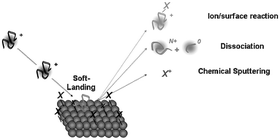Ion/surface collision phenomena in the hyperthermal collision energy regime (1–100 eV) are reviewed, with emphasis on chemical processes associated with the impact of small organic and biological ions at functionalized self-assembled monolayer surfaces. Inelastic collisions can lead to excitation of the projectile ion and can result in fragmentation, a process known as surface-induced dissociation which is useful in chemical analysis using tandem mass spectrometry. Changes in charge can accompany ion/surface collisions and those associated with a change in polarity (positive to negative ions or vice versa) are an attractive method for ion structural characterization and isomer differentiation. The surface-induced charge inversion of nitrobenzene and other substituted aromatics is discussed. Reactive collisions occurring between gaseous ions and surfaces depend on the chemical nature of the collision partners. These reactions can be used for selected chemical modifications of surfaces as well as for surface analysis. Particular emphasis is given here to ion soft-landing, another type of ion/surface interaction, in which the projectile ion is landed intact at the surface, either as the corresponding neutral molecule or, interestingly but less commonly, in the form of the ion itself. The ion soft-landing experiment allows for preparative mass spectrometry; for example the preparation of pure biological compounds by using the mass spectrometer as a separation device. After separation, the mass-selected ions are collected by soft-landing, at different spatial points in an array. If the experiment is performed using a suitable liquid medium, in the case of some proteins at least, biological activity is retained.

You have access to this article
 Please wait while we load your content...
Something went wrong. Try again?
Please wait while we load your content...
Something went wrong. Try again?


 Please wait while we load your content...
Please wait while we load your content...